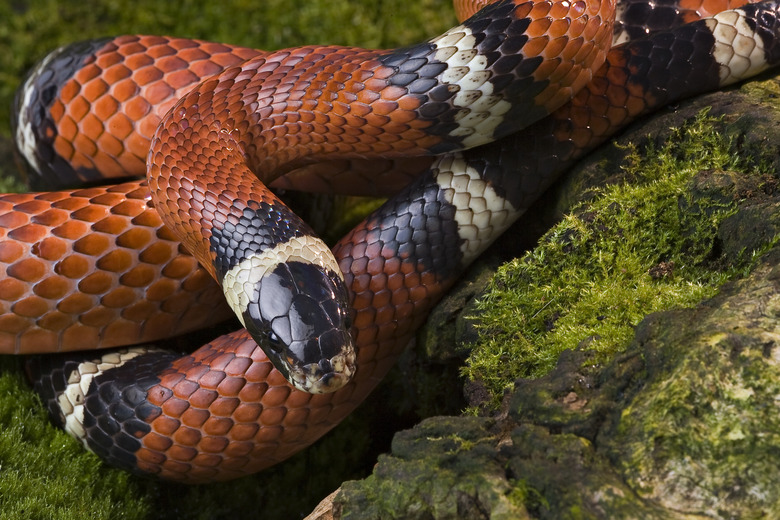How To Identify A Copperhead Vs. A Milk Snake
Being able to distinguish venomous from non-venomous snakes is an important and life-saving skill to have in areas where both types of snake are present. The copperhead snake (Agkistrodon contortrix) is a venomous snake found in North America that risks being confused with the similar-looking, nonvenomous milk snake (Lampropeltis triangulum). You can use visual and behavioral cues to tell them apart.
Step 1
Look at the color. Copperhead snakes are usually a pale-tan to pinkish-tan color that darkens towards the middle of the snake. Milk snakes are a noticeably brighter pinkish-red color.
Step 2
Look at the scale pattern. Copperhead snakes have 10 to 18 crossbands (stripes) that are pale-tan to pinkish-tan in color. The crossbands are about two scales wide at the spine but can become as wide as six to 10 scales along the sides.
Milk snakes have glossier and smoother scales than copperheads. Milk snakes have alternating bands of red-black-yellow or white-black-red.
Step 3
Note the size. Approximate from a safe distance, as approaching a snake you haven't yet identified could be dangerous. Copperheads are typically 20 to 37 inches long, but can grow to as large as three feet. Copperheads typically have stout bodies with a broad head.
Milk snakes typically grow 20 to 60 inches long and are significantly thinner and more streamlined than copperheads.
Step 4
Note the location. Copperheads are most often found in the south and southwest in the United States but are also known to exist in the midwest and along the Atlantic coast. Milk snakes have a wider range than copperheads and can be found almost anywhere east of the Rocky mountains.
Step 5
Note the habitat. Copperheads favor deciduous forests and mixed woodlands. Milk snakes can thrive in a variety of habitats and favor both coniferous and deciduous habitats as well as tropical hardwood forests, prairie and agricultural fields.
Step 6
Note the behavior. Copperheads are social snakes and are often found near one another when sunning, courting, mating, or denning. Males are aggressive during breeding season and can sometimes be seen wrestling each other to the ground. Some copperheads have been seen in ponds and streams and in low-hanging tree branches.
Milk snakes are a nocturnal species who are often spotted crossing country roads at night, moving during the day only to seek refuge from the heat. They are usually seen under brush piles or rotting logs. Milk snakes are solitary snakes who form groups only during hibernation.
Warning
Coral snakes (another species of venomous snake) have a very similar color pattern to milk snakes, except with transverse stripes: some people remember the difference with the phrase, "Red on yellow, deadly fellow; Red on black, venom lack."
Cite This Article
MLA
Cole, Simone. "How To Identify A Copperhead Vs. A Milk Snake" sciencing.com, https://www.sciencing.com/identify-copperhead-vs-milk-snake-8579039/. 13 March 2018.
APA
Cole, Simone. (2018, March 13). How To Identify A Copperhead Vs. A Milk Snake. sciencing.com. Retrieved from https://www.sciencing.com/identify-copperhead-vs-milk-snake-8579039/
Chicago
Cole, Simone. How To Identify A Copperhead Vs. A Milk Snake last modified March 24, 2022. https://www.sciencing.com/identify-copperhead-vs-milk-snake-8579039/
